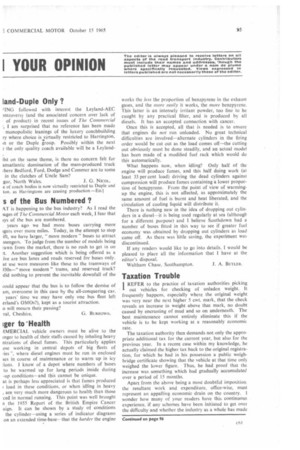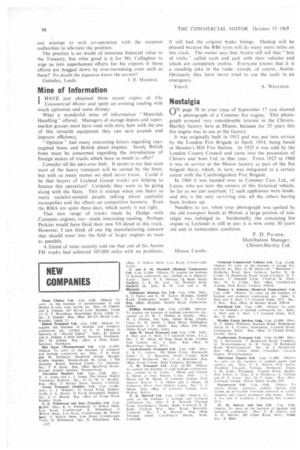I YOUR OPINION
Page 97

Page 98

If you've noticed an error in this article please click here to report it so we can fix it.
land-Duple Only ?
IING followed with interest the Leyland-AEC )ntroversy (and the associated concern over lack of of product) in recent issues of The Commercial I am surprised that no reference has been made monopolistic leanings of the luxury coachbuilding ry where choice is virtually restricted to Harrington, ,n or the Duple group. Possibly within the next the only quality coach available will be a Leyland
ilst on the same theme, is there no concern felt for ansatlantic domination of the mass-produced truck 'here Bedford, Ford, Dodge and Commer are to some in the clutches of Uncle Sam?
gor. North Wales. J. G. NtcoL.
e of coach bodies is now virtually restricted to Duple and ton. as Harringtons arc ceasing production.—Eni
S of the Bus Numbered ?
AT is happening to the bus industry? As I read the 'ages of The Commercial Motor each week, I fear that tys of the bus are numbered.
years ago we had more buses carrying more igers over more miles. Today, in the attempt to stop ift, we have larger, "more modem" buses to attract ssengers. To judge from the number of models being rawn from the market, there is no rush to get in on !.t. Another suggestion which is being offered as a .ive are bus lanes and roads reserved for buses only. at use were measures like these to the tramways of )30s—" more modern" trams, and reserved track? did nothing to prevent the inevitable downfall of the you'd appear that the bus is to follow the demise of am, overcome in this case by the all-conquering car. years' time we may have only one bus fleet left erland's OMOs?), kept as a tourist attraction. o will mourn their passing?
rat. Cheshire. G. BURROWS.
'ger to 'Health
4MERCIAL vehicle owners must be alive to the inger to health of their staffs caused by inhaling heavy ntrations of diesel fumes. This particularly applies ose working in central depots of big fleets of ties ", where diesel engines must be run in enclosed ses in course of maintenance or to warm up in icy :ions. I know of a depot where numbers of buses to be warmed up for long periods inside during -up conditions—and this cannot be unique.
at is perhaps less appreciated is that fumes produced load in these conditions, or when idling in heavy , are very much more dangerous to health than those ced in normal running. This point was well brought n the 1955 Report of the British Empire Cancer aign. It can be shown by a study of conditions the cylinder—using a series of indicator diagrams on an extended time-base—that the harder the engine works the less the proportion of benzpyrene in the exhaust gases, and the more easily it works, the more benzpyrene. This latter is an intensely irritant powder, too fine to be caught by any practical filter, and is produced by all diesels. It has an accepted connection with cancer.
Once this is accepted, all that is needed is to ensure that engines do not run unloaded. No great technical difficulties are involved—alternate cylinders in the firing order would be cut out as the load comes off—the cutting out obviously must be done steadily, and an actual model has been made of a modified fuel rack which would do this automatically.
What happens now, when idling? Only half of the engine will produce fumes, and this half doing work (at least 33 per cent load) driving the dead cylinders against compression will produce fumes containing a lower proportion of benzpyrene. From the point of view of warming. up the engine, this is not affected, as apploximately the same amount of fuel is burnt and heat liberated, and the circulation of cooling liquid will distribute it.
There is nothing new in the idea of dropping out cylinders in a diesel—it is being used regularly at sea (although for a different purpose) and I believe Southdown had a number of buses fitted in this way to see if greater fuel economy was obtained by dropping out cylinders as load came off. As there was little saving, the experiment was discontinued.
If any readers would like to go into details, I would be pleased to place all the information that 1 have at the editor's disposal.
Waltham Chase, Southampton. J. A. BUTLER.
Taxation Trouble
I REFER to the practice of taxation authorities picking
out vehicles for checking of unladen weight. It frequently happens, especially where the original weight was very near the next higher 5 cwt. mark, that the check reveals an increase in weight above that mark, no doubt caused by encrusting of mud and so on underneath. The best maintenance cannot entirely eliminate this if the vehicle is to be kept working at a reasonably economic rate.
The taxation authority then demands not only the appropriate additional tax for the current year, but also for the previous year. In a recent case within my knowledge, he actually claimed the higher tax back to the original registration, for which he had in his possession a public weighbridge certificate showing that the vehicle at that time only weighed the lower figure. Thus, he had proof that the increase was something which had gradually accumulated over a period of 15 months.
Apart from the above being a most doubtful imposition. the resultant work and expenditure, office-wise, must represent an appalling economic drain on the country. I wonder how many of your readers have this continuous experience, if any schemes have been initiated to get over the difficulty and whether the industry as a whole has made
any attempt to seek co-operation with the taxation authorities to alleviate the position.
The practice is no doubt of immense financial value to the Treasury, but what good is it for Mr. Callaghan to urge us into superhuman efforts for his exports if those efforts are bogged down by ever-increasing costs such as these? No doubt the Japanese know the answer!
Guiseley, Leeds. J. E. HARMER.
Mine of Information
I HAVE just obtained three recent copies of The I Conunercial Motor and spent an evening reading with much optimism and some dismay.
What a wonderful mine of information Materials Handling" offered. Managers of storage depots and supermarket groups must have,read with env)/ how with the use of this versatile equipment they can save pounds and improve efficiency.
" Opinion " had many interesting letters regarding rearengined buses and British diesel engines. Surely British firms must be concerned regarding the introduction of foreign makes of trucks which have so much to offer?
Consider all the take-over bids. It seems to me that soon most of the heavy transport will be owned by the State. but with so many names we shall never know. Could it be that buyers of Leyland Group trucks are helping to finance this operation? Certainly they seem to be going along with the State. This is strange when one hears so many socialist-minded people talking about capitalist monopolies and the effects on competitive business. Even the RHA are quiet these days, which surely is not right.
That new range of trucks made by Dodge--with Cummins engines, too—made interesting reading. Perhaps Perkins would have liked their new V8 diesel in this truck. However, I can think of one big manufacturing concern that should enter into the field of larger engines as soon as possible.
A friend of mine recently told me that one of his Austin FH trucks had achieved 107,000 miles with no problems. It still had the original brake linings. Dunlop will be pleased because the RB6 tyres will do many more miles on this truck. The owner says that Austin still sell that "box of tricks " called tools and jack with their vehicles and which are completely useless. Everyone knows that it is a standing joke in the trade—except, of course. Austin. Obviously they have never tried to use the tools in an emergency.
Yeovil. A. WESTMAN.
Nostalgia
page 78 in your issue of September 17 you showed a photograph of a Commer fire engine. This photograph aroused very considerable interest in the ChiversHartley factory here at Histon, because for 35 years this fire engine was in use at the factory.
It was originally built in 1913 and was put into service by the London Fire Brigade in April, 1914, being based at Shooter's Hill Fire Station. In 1925 it was sold by the London County Council and came into the possession of Chivers and Sons Ltd. in that year. From 1925 to 1960 it was in service at the Histon factory as part of the fire brigade there, which, in turn, was integrated to a certain extent with the Cambridgeshire Fire Brigade.
In 1960 it was handed over to Commer Cars Ltd., of Luton, who are now the owners of this historical vehicle. So far as we can ascertain. 12 such appliances were made, and this is the only surviving one. all the others having been broken up.
Needless to say, when your photograph was spotted by the old transport hands at Histon. a large portion of nostalgia was indulged in. Incidentally, the remaining fire engine (a Leyland) is still in use; it is now some 30 years old and in immaculate condition.
F. D. PALMER,
Distribution Manager.
Chivers-Hartley Ltd. Histon. Cambs.








































































































































